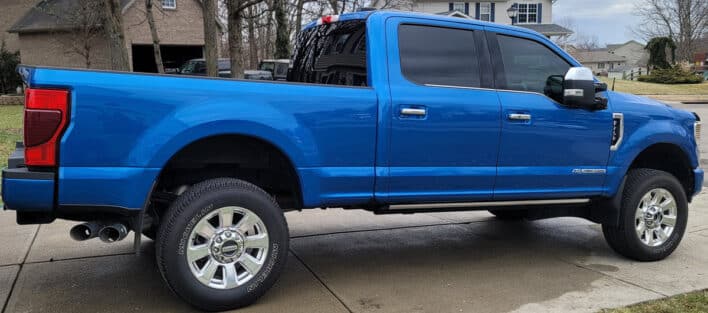Last updated on February 26th, 2024
Last weekend, I was at home working in the garage, cleaning, and putting things in their places after having a brief stint with spring (it lasted for two afternoons). Also, I performed clay bar detailing on the tailgate of my son-in-law’s 2015 Blue Ford truck. During this time, I had the opportunity to reflect on the following topic I would write about. Afterward, I had to return my detailing chemicals, hoses, and pressure washer to the basement so they would not freeze in the garage.
I decided to write about the two processes for decontaminating the surfaces of a car. The first process is chemical decontamination, and the second is automotive clay bar detailing. Clay bar detailing is known as mechanical decontamination. Several of you might ask, what are chemical decontamination and automotive clay bar detailing or decontamination & why are they important? I would tell you that you will have to stick around and read the rest of this post. You won’t want to miss what it does for your car’s paint job.
Affiliate Marketing Disclaimer: I am an affiliate marketer with links to online retailers on my website. When people read what I have written about a particular product, click on those links, and buy something from those links, I earn a small commission from the retailer at no extra cost to the buyer.
The Chemical Decontamination Process.

I would be irresponsible to discuss clay bar detailing without first addressing the chemical decontamination process. I investigated the topic thoroughly and decided that the best way to broach it was to look at it from the position of removing contaminants that are chemically bonded to the car’s surface. Often, these contaminants are small enough to be missed without chemical decontaminating first. You see these contaminates more prevalently on lighter-colored vehicles, specifically white and silver cars. They appear as tiny orange specs or fissures on the paint’s surface. I can see them on my F-250, which is a deep blue.
Both forms of decontamination are crucial for removing embedded debris caught in the clear coat on the car’s exterior. You do not want to start with the clay bar because you will be rubbing the clay bar on the exterior surfaces, and you could mar or scratch the surface with contaminants caught in the clay bar. These processes for decontaminating the vehicle’s surfaces provide clarity, luster, shine, and reflection unmatched by simply washing and waxing a car.
Steps for Chemically Decontaminating Your Car
Disclaimer: When using chemicals of any kind, read all the indications and warnings on the labels. Do not let them dry on the surfaces of your vehicle, and do not use them in direct sunlight or on hot surfaces. Always use them in a well-ventilated area.
The chemicals are safe for all clear-coated surfaces. You can use them on glass, fiberglass, wheels, and metal. You can also use them on ceramic-coated and graphene-coated surfaces. Please do not use them weekly or straight up as a cleaner. They do not contain enough solvents and surfactants to correctly clean the rest of the dirt from the wheels. They are usually pH-neutral and have little to no cleaning properties.
Steps to Complete a Chemical Decontamination Process.
- Wash the vehicle thoroughly to remove any loose dirt, grime, or debris on the surface.
- Drying the vehicle after this wash is unnecessary, but it will not hurt if you dry the car. If you decide to dry the vehicle, the chemicals may work more efficiently because they are not getting diluted.
- Apply iron remover to the surfaces of the vehicle. It is used to chemically react in an exothermic reaction against the iron fallout and the brake dust. Iron remover changes colors while dwelling on the surfaces of the car. This color change is known as the bleeding process. It exothermically reacts against iron particles, accelerating the oxidation process and allowing it to be rinsed easily.
- Next, use a tar remover to clean off any tar and asphalt from the vehicle. I found that the tar remover is excellent for removing undercoating overspray.
- There are two-in-one bug and tar removers in the marketplace that I have used. Still, I have found I like the chemicals specific to my job. You will need a quality bug-removing chemical to clean the front apron, grille, mirrors, and other parts exposed to bug guts.
See the video DETAILING 101: Iron & Tar Removers – Everything You Need To Know from Pan, The Organizer.
Why You Should Care About Clay Bar Detailing Your Car!
Disclaimer: Automotive clay detailing is not for the faint of heart. Do not use a clay bar on a ceramic-coated or graphene-coated vehicle’s finish.
If you feel that clay bar detailing will be too intricate, please seek further guidance or pay a professional to perform the work.
Clay bar detailing and synthetic clay detailing are processes by which you use abrasives and chemicals to remove contamination from the surface of your car. Contamination comes in many forms, but below is a list of the typical ones to concern yourself with. Remember, the following list is not all-inclusive. Other forms of debris that stick to your paint’s surface can cause it to look and feel dull or rough. A way to find out how rough your car’s surface is will be to place a sandwich baggie over your hand and slide it over the surface of your vehicle.
Here is a list of the contaminants you can expect depending on your environment.
- Industrial Fallout
- Brake Dust
- Rail Dust
- Tree Sap
- Road Tar, grease, and grime
- Undercoating Over Spray
- Adhesives
- Bug Guts
- Bird Droppings
The main reasons for clay bar detailing are to remove the contaminates and achieve a smooth, glass-like, clean surface. Clay bar detailing restores the deep, lustrous original shine and color. Also, it prepares the surface for other detailing, such as polishing, buffing, and waxing. By removing the contaminants, you can prevent further damage to the paint. If left unaddressed, the impurities can cause etching, corrosion, and other damage to your vehicle’s surfaces.
Clay Bar Detailing – Known as Mechanical (Paint) Decontamination.
The clay bar detailing process involves using specialized automotive clay with a lubricant. The clay is soft with some elasticity, so it can be molded to your hand and glides evenly over the surfaces of your car. The contaminants are embedded into the clay as you move the clay over the vehicle surface.
Important Notes: You must use a lubricant not to scratch the painted surfaces with the clay. Always keep the surfaces and the clay lubricated. If you drop the clay on the ground, do not use it on any car surfaces; throw it in the garbage and break off another piece of clay.
Steps to Successfully Clay Bar Detail Your Car.
Below are the steps and links to some of my previous articles if you need to refer to them for guidance.
- Wash the vehicle thoroughly to remove any loose dirt or debris on the surface.
- Break off a small piece of the clay bar, flatten it, and knead it in your hand until it becomes pliable.
- Spray your clay lubricant on a small section of the car’s surface that you plan to work on and on the clay. The lubricant will help the clay bar glide over the surface without scratching.
- Gently rub the clay bar back and forth over the lubricated surface. You should feel some resistance as the clay bar picks up contaminants from the surface. Continue until the surface feels smooth. Important Note: Do not use the clay bar in a circular motion. Circular motions will scratch the surface of your vehicle.
- Fold the clay bar over and use a clean section to repeat the process until you have clay-barred the entire vehicle surface.
- Wipe the surface dry and clean with a microfiber towel to remove any excess lubricant or clay residue.
- Repeat the process on any areas that still feel rough.
After completing the clay bar process, you should follow up with polishing, buffing, and waxing to protect the vehicle’s paint and give it a deep, lustrous shine. Another essential fact about detailing clay is that it goes a long way and can be used for many cars.
Another excellent video from Pan, The Organizer, discusses and shows the process of clay bar detailing.
How Often and When Should You Clay Bar Detail Your Vehicle?
A good rule for clay bar detailing is to do it twice annually. I perform clay bar detailing on my truck in the early spring and late fall for the added protection it provides during the two harsher seasons of the year. You can apply chemical decontamination every three to four months and as needed.
All in All…
I provided the differences and similarities between chemical and clay bars or mechanical decontamination (detailing). Also, I provided the steps with videos and pictures to reinforce the concepts. I hope you enjoyed the information about Automotive Clay Bar Detailing & Why it is Important. Please note the disclaimers and warnings.
As I have stated, I would start with chemical decontamination, and once complete, I move on to mechanical decontamination with my clay bar and lubricant. After this, I would machine polish the car, buff it, and then add a wax ceramic or graphene coating coat. I will discuss ceramic and graphene in future posts.
If you enjoyed the post, please share it on social media. I look forward to hearing your questions, tips, comments, and suggestions in the comments section below.

